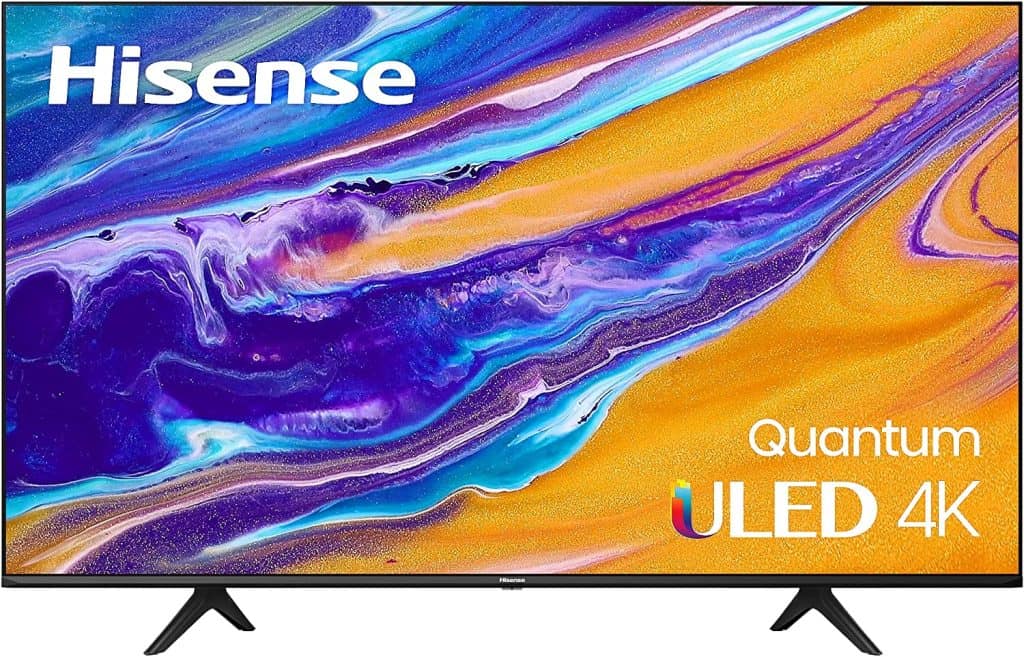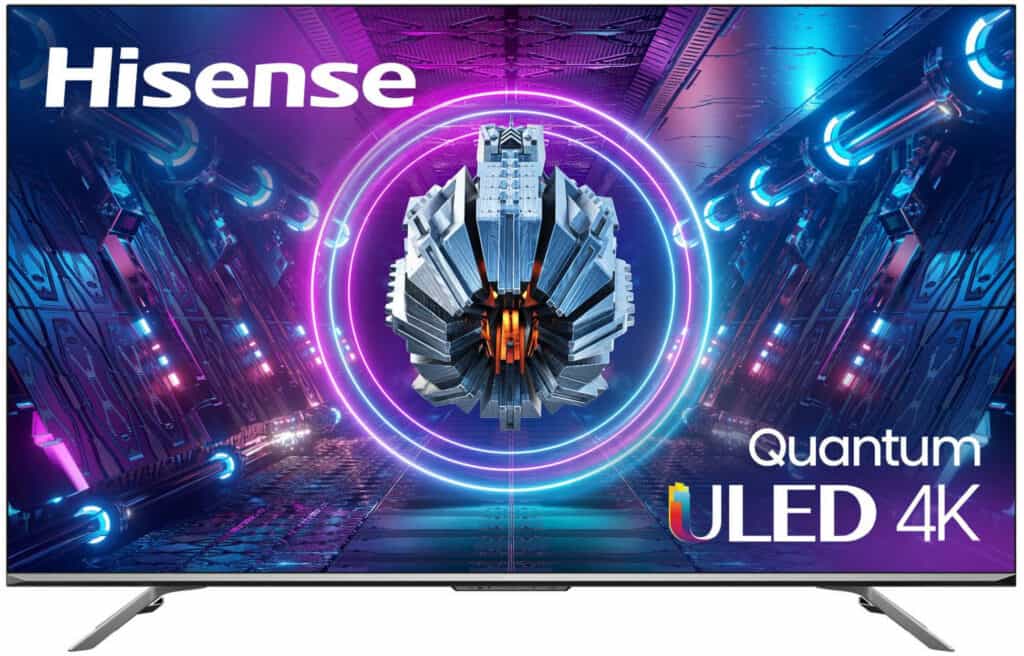When it comes to budget TVs, Hisense rarely misses the mark. The same is true for its UxG models.
In this article, we’ll compare Hisense U6G vs U7G and see which Hisense TV is better.
Hisense U6G vs U7G – Overview
| Features | Hisense U6G | Hisense U7G |
|---|---|---|
| Screen Sizes | 50, 55, 65, and 75 inches | 55, 65, and 75 inches |
| Screen Panel | VA | VA |
| Processor | MediaTek MTK SoC with ARM Cortex quad-core CPU | MediaTek MTK SoC with ARM Cortex quad-core CPU |
| Operating System | Android TV 9 OS | Android TV 10 OS |
| Refresh Rate | 60 Hz | 120 Hz |
| Variable Refresh Rate (VRR) | No | Yes |
| Resolution | 4K | 4K |
| Contrast Ratio | 5,200: 1 | 6,300: 1 |
| HDMI Ports | 4 | 4 (2 HDMI 2.1) |
| USB Ports | 2 | 2 (1 USB 3.0) |
| Wi-Fi and Bluetooth | Yes | Yes |
| Speakers | 2 (24 Watts output) | 2 (24 Watts output) |
| Price | Check Price on Amazon | Check Price on Amazon |
Both models came out in 2021 as part of the Hisense ULED lineup, which also includes the pricier U8G and U9G. Despite this, U6G and U7G are still excellent lower-cost options.
Hisense U6G

Despite being positioned as an entry-level model in the 2021 Hisense ULED lineup, the U6G model still performs very well and better than most TVs from other manufacturers in the same price range.
Note that U6G was replaced last year by U6H.
Pros:
- Budget-friendly
- Very good contrast in both SDR and HDR
- Excellent response times
- Supports a wide variety of resolutions
Cons:
- Narrow viewing angles
- Reflection handling is decent at best
- Lacks HDMI 2.1 and USB 3.0
- Mediocre sound quality
Hisense U7G

Sitting just above the U6G model, Hisense U7G is a very good mid-range TV with a solid list of features.
Pros:
- Excellent contrast
- Very good image quality in both SDR and HDR
- Outstanding gaming performance
- Great response times
Cons:
- Narrow viewing angles
- Not the best reflection handling
- Black uniformity could be better
Do you have a problem with your Hisense TV? Check out our Hisense troubleshooting guide, we probably have an answer.
Features Face to Face
Panel Technology
Both TVs use LED displays with VA (Vertical Alignment) panels and also have a Full Array with Local Dimming (FALD) backlight. This type of backlight separates the direct LED lighting’s backlight array into zones. Each zone illuminates a part of the screen and can be dimmed or brightened depending on the content on its part of the screen.
Hisense also offers models with LED, OLED and QLED panels for the U6G and U7G.
Winner: Draw
Image Processor
Like most other Hisense TVs, these two models use the MediaTek MTK chip with ARM Cortex quad-core processors.
Winner: Draw
Motion Technology
Here’s where we finally see some differences.
Both TVs have excellent response times and smooth motion, with Hisense U6G even having better response times at 11.6 ms vs U7G’s 13.5 ms.
Where U7G beats its cheaper cousin is in having some extra features like Variable Refresh Rate (VRR) and Motion Interpolation. The U7G also beats the U6G at removing judder in 24p content (U6G can’t remove judder from 60 Hz).
Both TVs also have optional BFI (Black Frame Insertion).
Also, most Hisense TVs offer a refresh rate of 60Hz and that goes for U6G as well. However, U7G has a native refresh rate of 120 Hz, giving it another clear advantage.
Winner: Hisense U7G
Picture Quality
Contrast Ratio / Black Levels
Although neither of the two TVs has an infinite contrast ratio (the ratio between whites and blacks on the screen), they’re still okay and can produce deep blacks in dark rooms.
Hisense U7G gets a little brighter with 6300: 1, while U6G has a contrast of 5200: 1.
Winner: Hisense U7G
Local Dimming
Local dimming feature is available on both TVs and it will slightly improve contrast, but not by much.
Winner: Draw
Peak Brightness
Really good peak brightness from both TVs here, but the U7G performs better in terms of max brightness with 950 nits compared to U6G’s 760 nits.
When it comes to SDR content, they’re close, with U7G being slightly brighter with 615 nits vs 493 nits on U6G.
However, the real difference is if you’re watching HDR content. Here, U7G has around 630 nits, while U6G has around 450 nits.
Winner: Hisense U7G
Color
Excellent color on both TVs in terms of gamut (how many colors the TV can display) and volume (how many colors the TV can display through the luminance range).
In terms of color gamut, Hisense U6G can display around 94-95% of the DCI P3 color space, which is great.
In comparison, U7G is capable of displaying around 92-93% DCI P3 color space.
The U7G is a little better when it comes to color volume and it can display most colors brighter than U6G.
For instance, the yellow luminance on U7G is 900+ nits, while on U6G just above 500 nits, green is 700 nits vs 400 nits, while the white luminance is around 1,000 nits vs 500 nits and so on.
Winner: Hisense U7G
Viewing Angles
As with all VA panels, you won’t be enjoying U6G or U7G in a wide-seating setting, unfortunately, as they both have narrow viewing angles.
Brightness is lost at around 35 degrees on both TVs and you’ll see color washout from 25 degrees onward.
If narrow viewing angles on VA panels bother you too much, you can check out IPS panels. We covered the major differences between the two and included TN panels in our comprehensive display panel types comparison post.
Winner: Draw
Reflections / Anti-Glare
These two TVs handle reflections decently and their semi-gloss finish helps nicely with this.
Still, reflection is visible on both the U6G and U7G, so watching them in a brightly lit room is not recommended.
Winner: Draw
Sound Quality
Audio quality isn’t the best and is largely mediocre for both, but that goes for most TVs in general. Both can handle distortion well when you don’t crank the volume up high, which is when it becomes more audible.
If you’re looking for a budget TV with good sound quality, the TCL 6 Series or the Insignia F50 are better choices.
Winner: Draw
Smart TV Platform (Operating System)
Hisense U6G and U7G both use the Android TV smart OS platform. The only difference here is that U7G uses the upgraded Android TV version 10, while U6G is on Android TV version 9.
However, there’s not a big difference between the two and they are both easy to use, smooth and with a lot of apps.
Winner: Draw
Connectivity
Inputs
Although both TVs have an equal number of ports (four HDMI and two USB), the fact that Hisense U7G supports HDMI 2.1, gives it a clear edge here over U6G. In addition, U7G also supports the latest USB 3.0 standard, which U6G does not.
| Inputs | Hisense U6G | Hisense U7G |
|---|---|---|
| HDMI | 4 ports (4x HDMI 2.0) | 4 (2x HDMI 2.0, 2x HDMI 2.1) |
| USB | 2 ports (2x USB 2.0) | 2 ports (1x USB 2.0, 1x USB 3.0) |
| Ethernet | 1 | 1 |
| Digital Optical Audio Out | 1 | 1 |
| 3.5 mm Analog Audio Out | 1 | 1 |
U7G also supports more resolutions, including 1080p@120Hz and 4K@120Hz, which U6G does not.
| Supported Resolutions | Hisense U6G | Hisense U7G |
|---|---|---|
| 1080p@60Hz | Yes | Yes |
| 1080p@120Hz | Yes | No |
| 1080p@144Hz | No | No |
| 1440p@60Hz | Yes (with forced resolution) | Yes (with forced resolution) |
| 1440p@120Hz | Yes (with forced resolution) | No |
| 1440p@144Hz | No | No |
| 4K@60Hz | Yes | Yes |
| 4K@120Hz | Yes | No |
| 4K@144Hz | No | No |
Winner: Hisense U7G
Voice Assistant
Both TVs have an integrated Google Assistant and are compatible with Amazon Alexa.
Winner: Draw
Wireless Technologies
When it comes to wireless technologies, that is Wi-Fi and Bluetooth, both U6G and U7G support 2.4 GHz and 5GHz Wi-Fi as well as Bluetooth 5.0.
Winner: Draw
Also Read: Our Hisense U7G vs U8G comparison
Conclusion
Although the differences between Hisense U6G vs U7G are mostly minor, they’re still there and most of them favor Hisense U7G, including better contrast, peak brightness and native refresh rate. Is it worth about $300 more? We’re not sure.
Buy Hisense U6G if you’re looking for:
- Affordable pricing
- Good contrast
- Low input lag
Buy Hisense U7G if you’re looking for:
- Excellent contrast
- Good peak brightness
- More supported resolutions
- 120Hz refresh rate
What we are sure of is that you’ll want to check out our Hisense H8G vs H9G comparison as well.